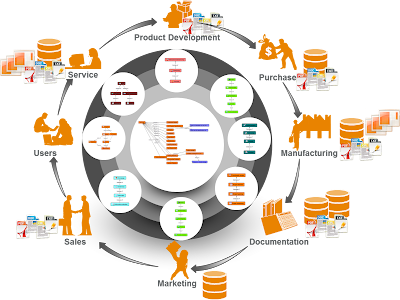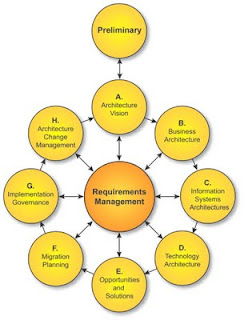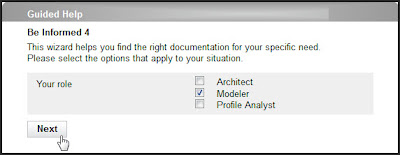The business case for smart documentation
In my previous posts I have focused on the benefits of semantic technology in documentation for end users. Semantic technology also offers a great opportunity to support the documentation creation and revision process. Semantic technology replaces a disconnected, post-hoc documentation routine with a dynamic process that is easily deployed, tested, reviewed and revised. Every relevant stakeholder can be involved in the documentation process, as users and as authors. Smart documentation builds internal engagement for the organization in the same ways that it builds external engagement in the customer base. The modular re-use and incremental revision of documentation will reduce total cost of documentation.
As illustrated in the example, in a semantic solution navigable content can be combined with executable frameworks into a business application.
So instead of going through a long explanatory text, users will be able to take an action based on a simple set of questions and answers.
Creating documentation starts in the first phases of product development and gradually grows to a smart documentation solution with multiple role- and context-based access paths. Changes in content or structure are easily performed and can be tested on the fly, because the documentation is instantly executable in a web browser.
As soon as a knowledge structure is worked out, it can be published. This could start as a publication for internal employees only, then incrementally roll out to additional audiences as it is reviewed. This makes it possible to develop and improve documentation based on user feedback and new insights.
Different views, additional guided steps, decision support, all can be added on the fly. Documentation becomes a natural, gradually growing live process. This will increase the continuity of work in an internal documentation department and gives documentation agencies the opportunity to build up long-term relationships with their customers.
Support all parties in the product life cycle
Using semantic technology in documentation makes it possible to optimize Product Life Cycle Management: It can support all documentation processes for all parties in the product life cycle. It also enables the re-use of information and knowledge models stored by all these different parties. Drafts of user stories created by Product Development could be used as source material by Documentation and Marketing. Knowledge models can be linked to support the core processes within the organization. This opens up new opportunities for technical communicators as the architects of this knowledge structure. The knowledge structure becomes the underlying support system for every phase of the process of product design, development, release and support. In fact the documentation model will represent the complete structure of the product and its context, available to all relevant internal and external users. |
| Figure 1. Product Life Cycle Management: the role of documentation in the product life cycle |
Example
A manufacturer serving industrial plants in the chemical industry must meet extensive safety and documentation standards to maintain certification. Their work is checked each year by an external certifying body.
Certification is a complex process, with detailed checklists, rules, instructions and regulations. The certifying agents are experienced industry professionals but compliance remains a challenge due to the volume of requirements.
A semantic documentation solution, optimized for the certifier as user, provides clear instructions based on the context, automates decisions, and records relevant details about how specific determinations were made. Every decision can be traced back to its source and made available in other processes.
Using the knowledge models and content provided by the manufacturer together with their own knowledge models and content, the certifying body makes optimal use of the available knowledge sources and always has the latest version of specific information available.
It can also work the other way around, with the manufacturer using the knowledge models from the certifying body to verify its own production, test or installation processes.
As illustrated in the example, in a semantic solution navigable content can be combined with executable frameworks into a business application.
 |
| Figure 2. Example of a Risk and Compliance knowledge base with executable frameworks |
Less content + more answers = higher value
One of the major strengths of semantic technology is that models and content combine in a conversational interface. Instead of several hundred words, covering all predicted cases, users in a semantic environment see a simple set of questions whose answers lead to a short and correct description of the solution. This will significantly decrease the total cost of documentation creation and maintenance, especially when the documentation is made available for multiple audiences. By creating context models for country-, language- and culture-specific aspects, the interface and content can be optimized for specific audiences. |
| Figure 3. Smart documentation versus traditional documentation is like comparing a navigation system with a written route description |
So instead of going through a long explanatory text, users will be able to take an action based on a simple set of questions and answers.
Growing live
Documentation is often started during the development of a product and ends soon after product launch. The documentation is finished when it is released. Semantic technology offers us the opportunity to change the character of the documentation process from a project-driven effort to a continuous improvement process that follows the life cycle of a product.Creating documentation starts in the first phases of product development and gradually grows to a smart documentation solution with multiple role- and context-based access paths. Changes in content or structure are easily performed and can be tested on the fly, because the documentation is instantly executable in a web browser.
As soon as a knowledge structure is worked out, it can be published. This could start as a publication for internal employees only, then incrementally roll out to additional audiences as it is reviewed. This makes it possible to develop and improve documentation based on user feedback and new insights.
 |
| Figure 4. Changes in content and structure are easily performed and can be tested on the fly |
Different views, additional guided steps, decision support, all can be added on the fly. Documentation becomes a natural, gradually growing live process. This will increase the continuity of work in an internal documentation department and gives documentation agencies the opportunity to build up long-term relationships with their customers.
Join me at the STC Summit 2013 for an interactive demonstration
As announced earlier, I will demonstrate how we can use semantic
technology to create process-driven documentation at the
STC Summit 2013 in Atlanta. I will do this by
live modeling with a semantic tool set. As the models in the semantic
environment are instantly executable, we can watch the documentation develop, change the models and review the results in a
web browser.
When: May 6th, 2:00 pm (EDT)
Where: Hanover FG, Hyatt Regency Atlanta - Track my session
Level: Advanced
When: May 6th, 2:00 pm (EDT)
Where: Hanover FG, Hyatt Regency Atlanta - Track my session
Level: Advanced
Download the white paper
The white paper “Improve Product and Brand engagement through smart documentation” is available for download on: http://info.beinformed.com/stc13 . This white paper will give you some background information for the session. Downloading requires an email address, so I can keep you up-to-date on future developments (there is always an opt-out).


Comments